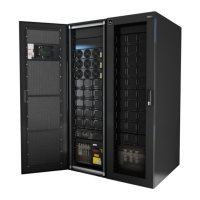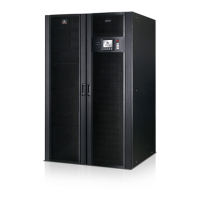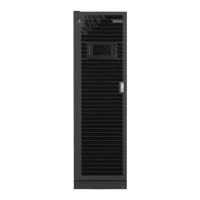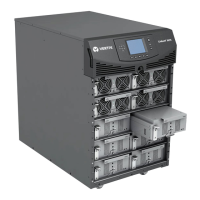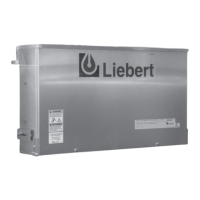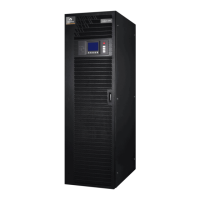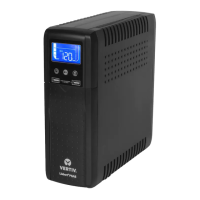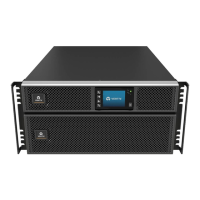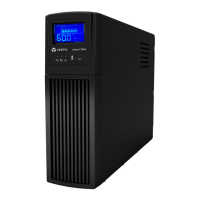Do you have a question about the Vertiv Liebert APM2 and is the answer not in the manual?
General safety guidelines for product installation and operation.
Vertiv disclaims liability for defects caused by improper use or non-compliance.
Safety symbols, warnings, and precautions for handling the UPS and its components.
Advantages of the UPS, including improved input power quality and protection.
Explanation of the UPS system's working principle and AC-DC-AC conversion.
How the Static Switch module manages load transfer between inverter and bypass.
Explains normal operation, mains abnormal conditions, and mains recovery.
Details the available UPS configurations with different switch options.
Describes the function and components of the Battery Circuit Breaker (BCB).
Information on connecting multiple UPS units for increased capacity and reliability.
Details various UPS operational modes including Normal, Battery, Bypass, ECO, and Dynamic Online.
Information on battery types and configuration for the BMS.
Safety precautions, general procedures, and transportation guidelines for installation.
Lists necessary tools and steps for unpacking the UPS and battery packages.
Procedures for inspecting the UPS and battery before installation.
Guidelines for UPS location, battery location, and storage conditions.
Cabinet composition, moving, clearance, cable access modes, and wiring considerations.
Schematic diagrams illustrating the installation of the 120 kVA UPS.
Instructions for connecting power cables, including sizing and current ratings.
Procedures for connecting signal cables for auxiliary functions and communication.
Steps for installing built-in lead-acid battery modules into the UPS.
Overview of the touchscreen panel, navigation, and access levels.
Components of the touchscreen display and how to customize its appearance.
Overview of UPS operations controllable via the touchscreen, including Inverter On/Off and Alarms.
How to view UPS status using the status gauge and panel, including logs and events.
How to check the status of individual UPS components.
Explains the status bar, its indicators, and the meaning of status messages.
Safety precautions and identification of power switches for single UPS operation.
Step-by-step guides for starting the UPS in Normal, ECO, and Battery modes.
Procedures for switching between Normal, Battery, Bypass, and Maintenance modes.
Information on performing manual and automatic battery tests.
Steps for safely powering down the UPS.
How to use the EPO function and reset the UPS after faults or EPO events.
How the UPS automatically restarts and procedures for language, date/time, and password settings.
Lists battery types and details charging/discharging management methods.
Covers battery tests, temperature compensation, and protection features.
Crucial safety precautions, hazardous voltage warnings, and installation guidelines for batteries.
Considerations for battery room design, common battery strings, and maintenance procedures.
Guidelines for the safe and legal disposal of used batteries.
Procedures for installing parallel UPS systems, including checks and cabinet installation.
Importance of protective devices, power cable, parallel, and LBS cables.
Using remote EPO and operational procedures for parallel UPS systems.
A list of available optional cards and accessories for the UPS.
Details on battery sensors, ground fault kits, seismic anchors, and communication cards.
Information on supported communication protocols like SNMP, Modbus, and dry contact.
Critical safety warnings and procedures for servicing power and bypass modules.
Details on key component lifespan, replacement times, and air filter replacement.
Common maintenance tasks for the UPS system and its options.
Lists European and international standards the UPS complies with.
Specifies environmental operating conditions like noise, altitude, and humidity.
Details mechanical frame specs and electrical characteristics of input rectifier.
Electrical specs for battery bus, inverter output, and bypass input.
Details on UPS efficiency and power loss.
Contact information and support details for Vertiv.
A glossary of terms used in the manual.
Information on hazardous substances in UPS components.
General safety guidelines for product installation and operation.
Vertiv disclaims liability for defects caused by improper use or non-compliance.
Safety symbols, warnings, and precautions for handling the UPS and its components.
Advantages of the UPS, including improved input power quality and protection.
Explanation of the UPS system's working principle and AC-DC-AC conversion.
How the Static Switch module manages load transfer between inverter and bypass.
Explains normal operation, mains abnormal conditions, and mains recovery.
Details the available UPS configurations with different switch options.
Describes the function and components of the Battery Circuit Breaker (BCB).
Information on connecting multiple UPS units for increased capacity and reliability.
Details various UPS operational modes including Normal, Battery, Bypass, ECO, and Dynamic Online.
Information on battery types and configuration for the BMS.
Safety precautions, general procedures, and transportation guidelines for installation.
Lists necessary tools and steps for unpacking the UPS and battery packages.
Procedures for inspecting the UPS and battery before installation.
Guidelines for UPS location, battery location, and storage conditions.
Cabinet composition, moving, clearance, cable access modes, and wiring considerations.
Schematic diagrams illustrating the installation of the 120 kVA UPS.
Instructions for connecting power cables, including sizing and current ratings.
Procedures for connecting signal cables for auxiliary functions and communication.
Steps for installing built-in lead-acid battery modules into the UPS.
Overview of the touchscreen panel, navigation, and access levels.
Components of the touchscreen display and how to customize its appearance.
Overview of UPS operations controllable via the touchscreen, including Inverter On/Off and Alarms.
How to view UPS status using the status gauge and panel, including logs and events.
How to check the status of individual UPS components.
Explains the status bar, its indicators, and the meaning of status messages.
Safety precautions and identification of power switches for single UPS operation.
Step-by-step guides for starting the UPS in Normal, ECO, and Battery modes.
Procedures for switching between Normal, Battery, Bypass, and Maintenance modes.
Information on performing manual and automatic battery tests.
Steps for safely powering down the UPS.
How to use the EPO function and reset the UPS after faults or EPO events.
How the UPS automatically restarts and procedures for language, date/time, and password settings.
Lists battery types and details charging/discharging management methods.
Covers battery tests, temperature compensation, and protection features.
Crucial safety precautions, hazardous voltage warnings, and installation guidelines for batteries.
Considerations for battery room design, common battery strings, and maintenance procedures.
Guidelines for the safe and legal disposal of used batteries.
Procedures for installing parallel UPS systems, including checks and cabinet installation.
Importance of protective devices, power cable, parallel, and LBS cables.
Using remote EPO and operational procedures for parallel UPS systems.
A list of available optional cards and accessories for the UPS.
Details on battery sensors, ground fault kits, seismic anchors, and communication cards.
Information on supported communication protocols like SNMP, Modbus, and dry contact.
Critical safety warnings and procedures for servicing power and bypass modules.
Details on key component lifespan, replacement times, and air filter replacement.
Common maintenance tasks for the UPS system and its options.
Lists European and international standards the UPS complies with.
Specifies environmental operating conditions like noise, altitude, and humidity.
Details mechanical frame specs and electrical characteristics of input rectifier.
Electrical specs for battery bus, inverter output, and bypass input.
Details on UPS efficiency and power loss.
Contact information and support details for Vertiv.
A glossary of terms used in the manual.
Information on hazardous substances in UPS components.
| Topology | Double Conversion Online |
|---|---|
| Relative Humidity | 0-95% non-condensing |
| Input Frequency | 50/60 Hz |
| Phase | 3-Phase |
| Battery Type | Valve-Regulated Lead Acid (VRLA) |
| Operating Temperature | 0°C to 40°C (32°F to 104°F) |
| Communication Interface | SNMP, Modbus |
| Dimensions (HxWxD) | Varies by model |
| Weight | Varies by model |
| Form Factor | Modular Rack/Tower |
